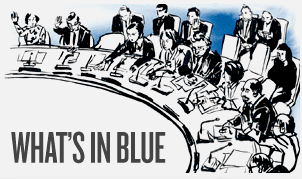Adoption of the Security Council Annual Report
Tomorrow ( 22 October), the Council is expected to adopt its annual report to the General Assembly covering the period from 1 August 2013 through 31 July 2014. (Under Article 24(3) of the UN Charter, the Security Council must submit an annual report to the General Assembly for its consideration.) Rwanda—which, as Council president in July was responsible for drafting the introduction of the report—is expected to speak ahead of the adoption.
It seems that Council members reached consensus on this year’s draft introduction to the annual report quite early and with relatively little fuss. Rwanda circulated a draft to Council members on the final day of its presidency on 31 July. Members then provided Rwanda with their comments, and four revised versions were circulated. Before the final version of the report was placed under silence procedure, outstanding issues related to children and armed conflict, the Democratic People’s Republic of Korea, the ICC, small arms, and Ukraine were worked out bilaterally. The report was put under silence procedure on 11 September.
It seems there had been interest from some members in having a broader discussion in the Council on the draft annual report. While several members seemed open to statements being made after the adoption, it seems that given the Council’s tight schedule tomorrow, some members felt that it would be difficult to fit in a wider discussion.
The last time there was a Council debate on this subject was in 2002. That year, largely at the initiative of Singapore, a number of changes were made to the report including an introduction that attempted to address the calls for more analytical content. In 2012, Portugal, at the time the chair of the Informal Working Group on Documentation and Other Procedural Questions, advocated holding a debate on the occasion of the adoption of the introduction of the report, scheduled during Guatemala’s presidency of the Council in October. The meeting, originally planned for 30 October, had to be postponed due to hurricane Sandy which forced the UN to close for several days. The report was finally adopted on 8 November without discussion.
However, several issues related to the annual report may be taken up on Thursday (23 October) during the open debate on Security Council working methods and during the presentation of the report to the General Assembly. They may also be addressed in the Working Group on Documentation and Procedural Questions. It seems that at the last meeting of the Working Group both Lithuania and Russia circulated papers with suggestions for how to make the preparation of the annual report more efficient.
Among the key concerns for some members are the growing size of the annual report and the rising costs of preparing and publishing the report. The 2002 Presidential Note S/2002/199 stipulated that the introduction to the annual report should be an analytical piece, seeking to capture the most important moments in the year under review, assess the Council’s ability to deal with problems at hand and signal difficulties and areas where improvements could be made. When this analytical introduction was first introduced in 2002 it was eight pages long. Over the years the introduction has grown in length and become a summary of the activities of the Council with little analysis. The 2013 introduction was 58 pages. Council members who feel that the introduction has become too lengthy may be open to considering setting a word limit.
The period covered by the annual report has also been the subject of some discussion lately. The report currently covers Council activities from 1 August to 31 July, and is drafted by the July Council president. Except in two cases since 2002, every time a non-permanent member drafted the report, it was a delegation in its first year in the Council. This has meant that the Council member drafting the report was not on the Council for the first five months of the period being covered. Some members may be ready for a discussion on possible shifting of the reporting period to a 1 January – 31 December cycle, with the report being presented to the General Assembly in the first quarter of the year.
With the rising costs of producing the annual report (estimated cost per page is $2,500) it seems that there may be greater attention paid to trying to make it a more useful resource. The annual report has been criticised over the years by General Assembly members for not being analytical enough and failing to shed light on how the Council makes its decisions.
There will be a change this year in how the annual report is considered in the General Assembly. In the last several years, the General Assembly’s consideration of the annual report has usually been done in conjunction with its discussion on Security Council reform. But this year, the president of the General Assembly decided to dissociate the two agenda items and to hold two different sessions. It seems the decision was made following a meeting with Accountability, Coherence and Transparency (ACT) members, a cross-regional group of 23 small and medium size member states interested in Council working methods. ACT members were keen to separate the two issues to allow the UN membership to reflect on both items individually and comment on each of the issues in separate formats. The General Assembly meeting on Security Council reform is currently scheduled for 12 November and its consideration of the Council’s annual report for 19 November.

